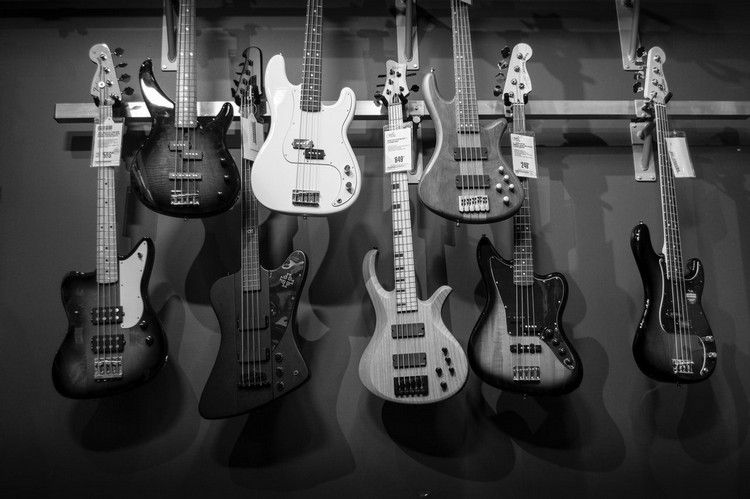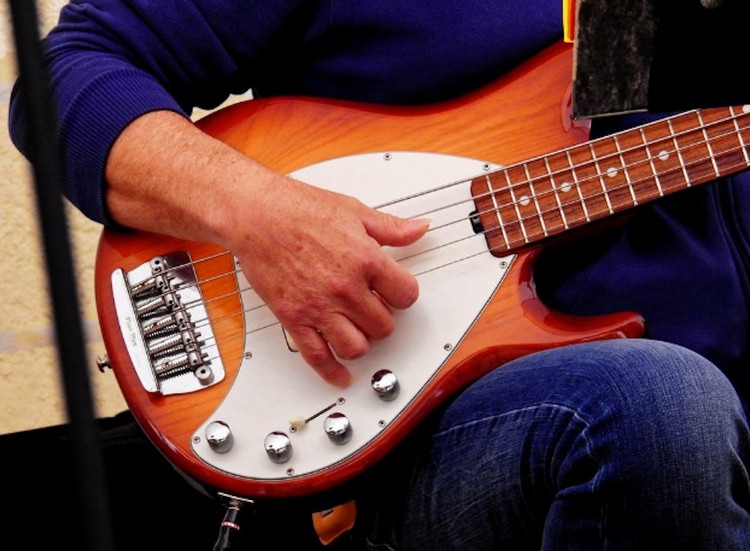The Benefit To Your Playing
Effective practicing of bass guitar exercises will do a number of things to both our bass guitar playing and our brains.
- For starters, practicing regularly helps us be more critical of our playing (which is never a bad thing, provided it’s constructive).
- Repeated practice of the same lines of music will teach you new ways of playing it, and help you to approach it differently.
This is the beauty of the interaction between music and our brains – Our ears will always find something new and exciting to hear, as well as different ways of interpreting familiar pieces of music.
As a bassist, rhythm is your meat and potatoes (unless you’re vegan) – with that, it’s important to focus on tightness. These bass guitar exercises will help get you there.
Tightness is born out of repeated practice, and it’s important to be detailed about it.
Pro Tip: Pay attention to the following:
- How you grip the note
- How it resonates – Is it buzzing? Does it ring clearly?
- How long you hold each note against the beat of the metronome
- The beat of the metronome
That’s right, we said it – Metronome.
- These guys get a bad reputation online, but metronomes help us learn and understand rhythm in a way that nothing else can.
- Consistently practicing these bass guitar exercises against a metronome will see you conquering the tabs below in no time.
Now without further adieu, let’s get to the practice routine.
Bass Guitar Exercises I – The Chromatic Scale
The chromatic scale is a tried-and-true exercise that gets the blood flowing in our fingers rather quickly, especially on the bass guitar.
This scale can be played easily at a slow speed, and sped up to increase the complexity.
Assign one finger to each fret in the first position. Your fingers should be set like so:
1st fret: Index
2nd fret: Middle
3rd fret: Ring
4th fret: Pinky
Be careful to assign one beat to each fret as you play. You can begin by playing whole notes at 80 beats per minute. That’s one note per beat.
Check out the ascending chromatic scale exercise below:
We can practice all of these bass guitar exercises in both ascending and descending patterns, but it’s even more important to do this with the chromatic scale.
- Movement in both directions is crucial for every type of stringed musician, and so practicing this scale backwards is just as effective as practicing it forwards.
- Once again, keep your fingers positioned the same way you would in the example above, and begin moving backward from the 4th fret on your G string.
Pro Tip: All of these routines can be played with a pick, or fingerpicked.
If you’re into fingerpicking, try playing these bass guitar exercises with two fingers and alternating between the index and middle.
This will help you gain momentum as you increase the speed of your metronome.
Let’s grind this one out below:
Bass Guitar Exercises II – Chromatic Scale Variation
Due to the fact that the chromatic scale is so straightforward, we can mix it up in a couple different ways to create new bass guitar exercises from it.
- In this example, we switch up the order of frets we play to create something a bit more complex than the first example.
- You can position your fingers the same way as you have been so far, but after we hit the first fret on the low E string, we jump to the third.
Pro Tip: Pay attention to the back-and-forth momentum of this finger drill and play it both with a pick and with your fingers.
The reason we selected this exercise is because it forces you to re-think something that you’ve already learned.
This creates a good habit of thinking outside the box when it comes to playing and writing music, as well as other bass guitar exercises.
Remember that any musical concept can be explored in a variety of different ways.
Often we will find new ways of playing those same musical concepts just by playing them over and over again.
This is the benefit in consistent and effective practice.
Pro Tip: Try to approach new concepts with this attitude every time you learn something new.
Instead of just learning a piece of music, explore it. Break it down. How does it work?
You don’t need music theory to explore music. Try and find as many ways to play the same piece as you can and we guarantee you’ll never be bored.
Bass Guitar Exercises III – The ‘Spider’ Shape
This is where things start to get tricky.
These bass guitar exercises will definitely challenge your hands and fingers, but it will leave your hands feeling loose, refreshed and ready to tackle anything.
- We call this one the ‘spider shape’ because your fingers will be crawling across the fretboard to make it happen effectively.
- We cannot stress enough how important it is to take this specific exercise slowly and stretch beforehand.
These spider-like bass guitar exercises will break apart the limitations on your fingers through effective practice, but don’t rush yourself.
Start on the first fret of the low E string, and move to the next string at the second fret with your middle. Repeat this for the ring and pinky until you have reached the G string at the fourth fret.
In similar fashion to the bass guitar exercises above, we’re going to turn this one around and go backwards down to the low E from the G string.
Start at the first fret on the G string and move one finger per string down to the low E at the fourth fret.
Pro Tip: Set your metronome low to start with and work your way up to a higher tempo once you feel comfortable doing so.
Don’t rush this exercise, take the time to let your hand and fingers stretch across the fretboard and you will notice breakthrough after breakthrough with your bass guitar playing.
Writer’s Advice: If you want more challenging ways of approaching scales, check out Adam Neely’s 5 hour major scale practice routine here.
Bass Guitar Exercises IV – Find New Grooves & Experiment
As we have said already, one of the most important things you can do is find new ways to play the same pieces of music.
In this exercise, we’re going to challenge our brains and learn a new rhythm and time signature:
5/4!
This groovy rhythm is perfect for the bassist who wants something fresh and new for their bass guitar exercises.
- We’re going to look at another variation on the chromatic scale for this exercise.
- Instead of playing from the first fret on the low E, we will instead begin with the open string to add an extra note to every string.
This totals five notes per string instead of four.
When playing these bass guitar exercises, we should always be counting to ensure we are keeping good time.
Adding an emphasis to the first beat of every bar helps us ‘feel out’ the rhythm of 5/4 better.
5/4 means five quarter notes per bar, so we should count it with emphasis like so:
One – Two – Three – Four – Five – One – Two – Three – Four – Five
Pro Tip: Want a quick way to figure out the 5 rhythm?
Put your hand on a desk and tap with every finger including the thumb, starting from the pinky.
Tap harder with the pinky than you tap with the other fingers, and you will have figured out the rhythm above.
Now let’s give this last exercise a run-through, then drink some water.
Where Do I Go From Here?
Not done with these bass guitar exercises just yet? Great! We recommend:
- Practice with a metronome to keep a steady pace
- Practice with and without a pick for different tones
- Use two and three fingers for picking through these exercises to stretch your picking hand
- Play these bass guitar exercises in different note groupings (2s, 3s, etc)
- Practice at one specific tempo (ex 120bpm) until you master it, then bump the tempo by 10bpm. If you find this is too fast, reduce it by 5. Repeat this process to build speed effectively.
Recommended Resources
If you loved this free resource from National Guitar Academy, you’re going to love some of the other bass guitar lessons we’ve got in store for you:
- How To Play Bass Guitar
- 9 Easy Ways To Learn Bass Guitar
- 6 Essential Bass Lessons
- Bass Guitar Scales – The Ultimate Guide
What Type of Guitarist Are You?
Take our 60-second quiz & get your results: Take The Quiz
Join the world's best online guitar school 🌎
- Get your own personalised guitar learning plan (customised just for YOU).
- World-class online guitar courses. Learn at your own pace.
- Community Campus & Learning Forum - A friendly community! Connect with our team & students. 😊
- Beginner Song library with chordsheets, tabs and tips. (Songs suitable for all levels!)
- Regular live streams, seminars and Q&A sessions - Learn from world-class guitar educators. Get all your questions answered!
Click here to learn more about National Guitar Academy membership 
Cool Guitar T-shirts 😎
Look cooler! Check out our merch: Click here to see our merch store
Want free guitar tips and video lessons delivered to your inbox?
Join over 250,000 other guitar learners and subscribe to our guitar-tips-by-email service. (It's free.)
We'll send you a series of lessons that will move you to the next level of your guitar journey.
Learn how everything fits together quickly, easily and effectively. We share ninja tips (for instant fun!) but also timeless fundamentals that will deepen your understanding.

Popular Lessons
How To Learn Guitar: An 11-Step Programme For Beginners
How To Choose The Perfect Beginner Guitar
More Cool Guitar Stuff
Learn about National Guitar Academy: About Us
Visit our YouTube channel for fun guitar videos.
Join us on Facebook for daily guitar tips.
Listen to our Learn Guitar Podcast for rapid guitar progress.
Check out our free chord lessons.
Get our best guitar tips & videos













